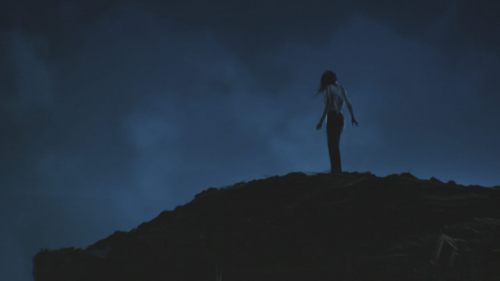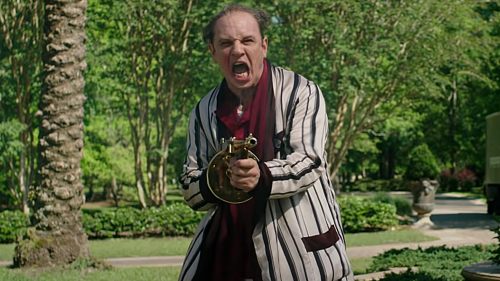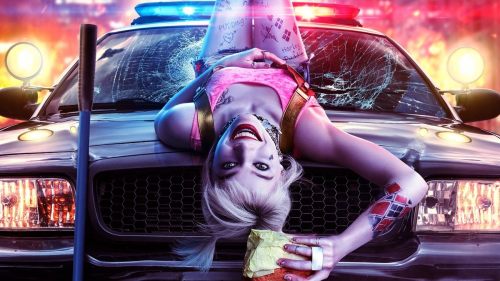POSSUM Review: Behold, The Most Beautifully Bleak Horror Film Of The Year
A blank face peering out the window of a disintegrating house. A jar of revolting green candies. A children’s book that reads like a nursery rhyme, and an incantation. A mysterious puppet kept hidden away in a leather duffel bag. This is Possum, Matthew Holness’s first feature-length film, which began as a short story featured in the anthology The New Uncanny. Holness sets his atmospheric story in Norfolk, in claustrophobic spaces and industrial places that feel not unlike Eraserhead. Possum is an uneasy, spare psychological thriller that draws from fairytales and films like Fritz Lang’s M, Cronenberg’s Spider, and Dreyer’s Vampyr.
Sean Harris plays tortured puppeteer Philip, who’s been forced to return to his childhood home after a scandalous performance that’s never fully explained. His house alone is reason enough for Philip to be miserable: it’s a dismal, gothic place that betrays the gloom of the people who live in it. Edgar Allan Poe could have been describing it in The Fall of the House of Usher. Philip’s parents died in a fire in their bedroom, but his cruel uncle, Alun Armstrong’s Maurice, still lives here. Maurice seems to spend his days waiting to taunt him, sitting around in the kitchen just across from a forbidding door that Philip refuses to open.
In his rare encounters with other human beings, Philip inspires anxiety. Suspicion surrounds him when a local boy goes missing, and the boy’s disappearance dredges up memories of a similar incident when Philip was young. In a desperate search for a place to rid himself of Possum - the puppet in his bag - Philip roams, runs, and stumbles around marshes, the woods, and industrial decay. DP Kit Fraser shot the movie on 35mm, giving the film a faded and textured ‘70s look, its palette dominated by rust, corrosive green and yellow, and inky darkness: rain, charcoal illustrations, soot, black balloons. Fraser’s cinematography, along with its mournful, unsettling score by the legendary BBC Radiophonic Workshop, make the film’s landscape feel like a visualization of Philip’s mind, with Philip getting lost in it, always retracing his steps in an inexorable retreading of the past.
In Possum, Sean Harris reestablishes that he’s one of the best working actors today. His most recognizable role is Solomon Lane in the last two Mission: Impossible films, and his performance in the miniseries Southcliffe rightly earned him a Leading Actor BAFTA. Harris shares a striking resemblance to Ian Curtis (his first feature-film role in 24 Hour Party People) with a touch of young Peter Cushing, and as Philip, he’s mesmerizing, with the expressive intensity of a silent film star like Conrad Veidt. Philip is simultaneously frightened and frightening, childlike, vulnerable; he hunches over, hands hanging limply in front of him, as if he doesn’t quite know what to do with himself when he isn’t carrying his literal baggage. Even when we suspect Philip may have done terrible things, Harris makes him sympathetic, even likable.
Philip is an unreliable narrator, and it’s hard to differentiate what’s real and what isn’t. Possum’s disjointed narrative never allows us to get our footing as we wonder whether each scene is dream, flashback, or reality, yet it’s never frustrating; rather, it slowly builds tension to a disturbing denouement. It’s like a haunted house story where Philip grapples with his ghosts, though sometimes it feels as if he’s the ghost. Possum’s scares are rooted in the uncanny, with Freudian subtext and a pervasive, unshakable sense of impending doom, but it may frustrate those looking for lots of gore, jump scares, and a conventional, linear narrative. And if you’re hoping for a comedy in the vein of Holness’s Garth Marenghi’s Darkplace, this film isn’t it. There is no levity, no release in Possum, only dread.
The film’s titular puppet is a big spidery thing that looks like a Jan Švankmajer or Brothers Quay creation, with a blank white face modeled after Harris’s own by designer Dominic Hailstone. “You show that to children?” Maurice asks the first time he sees Possum. It’s a nice antidote to over-the-top, contrived “scariness” of other modern creature designs like Annabelle, who looks like a juggalo’s ventriloquist dummy. Whether Possum is concealed from view or being shown in its full glory, the puppet is terrifying. It’s the perfect embodiment of the darkness Philip tries so desperately to suppress, a thing spawned by guilt, grief, repression, and trauma. Possum is about how our pain and fears “play dead,” only to resurface when we least expect them - and the more we try to bury the darkness, the more powerful it becomes.



